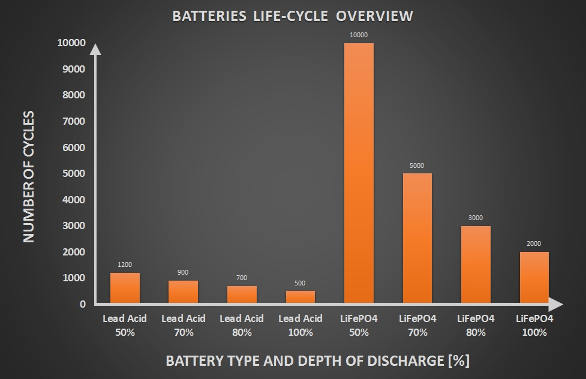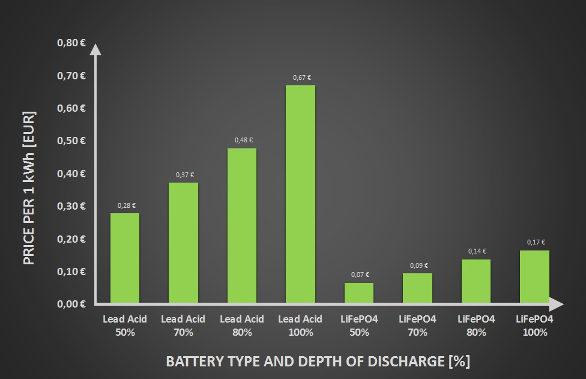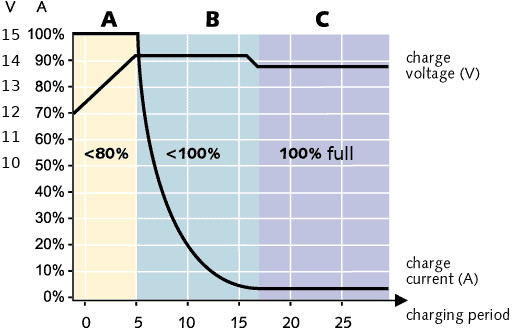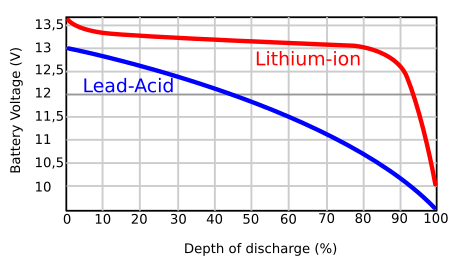In this article we will discuss "Lithium batteries". In fact there is a whole family of "Lithium batteries", all with a specific chemistry tailored for a specific use, optimised for weight, size, voltage and/or temperature range, etc. For use on sailing boats, only LiFePO4 (also sometimes referred to as LFP) is a sensible choice. In this article read "LiFePO4" wherever we write "Lithium". The statements made might not apply to other types of Lithium batteries.
Comparison
If you own a sail boat which spend most of its time off grid, you are probably very aware of the problems associated with lead-acid batteries. Let's compare them with Lithium batteries, side by side:
Durability

- Lead-acid batteries
- Lead-acid batteries on sail boats typically don't last very long. Lead-acid batteries perform very well to generate short term heavy current, like for starting an engine. They also last very long when they just need to provide backup power very occasionably. In both situations the lead-acid batteries spend most of their life fully charged. But lead-acid batteries hate to be discharged, and they hate to have to cycle (from charge to discharge and back again). Most manufacturers specify somewhere about 500 cycles, which is, with a daily cylce, a lifetime of less than 2 years! There is not much that can be done about it, it is just their chemistry which make them suffer from each single charge-discharge cycle and spending any time in a discharged state.
- Lithium batteries
- Lithium batteries love to cycle. They can perform a virtually infinite amount of cycles. The specifications often claim 5000 cycles and with very good care for the battery, it can be even more. But Lithium batteries hate to spend much time in a fully charged state. You might have bad experiences with Lithium batteries in consumer electronics, the typical "hardly ever used" batteries. This is usually due to the common mistake to charge these batteries after each use and let them spend most of their time in a fully charged state. On a sail boat, where the batteries are being discharged every night, the Lithium batteries will not suffer from spending too much time in a fully charged state, especially if the capacity is choosed wisely (not much more capacity than actually needed) and a good Battery Management System is being used.
Economy

- Lead-acid batteries
- Because lead-acid batteries usually don't last very long on an off grid sailboat, they are not an economic choice, despite their lower price. The lifetime is about 500-1000 cycles, provided you don't discharge them too deeply. The deeper the discharge, the shorter their lifetime. To get any meaningfull life out of lead-acid batteries, you can only use 30% or even less of the rated Amp-hours capacity.
- Lithium batteries
- Lithium batteries might be more expensive, until you realise that you can safely use 80% of their rated Amp-hours capacity. In practice, this means that to replace a 600 Ah lead-acid battery (which you could only discharge for 30%, which is about 200Ah), a 250 Ah Lithium battery (which can be discharged for 80%, which is 200Ah) will give you exactly the same usable capacity. Also, it lasts much longer, at least 3 to 5 times. If you don't buy the Lithium batteries from a marine shop but directly from the importer, and make the very conservative assumption that the battery will last 10 years, the lithium battery is by far the most economic choice.
Weight
- Lead-acid batteries
- The typical specific energy is 33-42 Wh/Kg. With about 30% usable capacity, this would equate to 10-13 Wh/Kg.
- Lithium batteries
- The typical specific energy is 100 Wh/Kg. With about 80% usable capacity, this would equate to 80 Wh/Kg.
This means that the lead-acid batteries are 6 to 8 times heavier per Wh storage than their lithium cousins. That might be important, especially on fast boats. After all, for every kilo of "boat", you will have to displace 1 kilo of water to move forward, which translates into drag...

The trajectory under A is called "bulk phase", B is called "absorption phase".
Charging
- Lead-acid batteries
- Lead-acid batteries suffer from a very frustrating charge curve: From around 80% of charge upwards, they don't accept the full available charge current anymore. In technical terms they transit from "bulk charge" to "absorption fase" (which we used to call "spoon feeding" on our sailboats). It is frustrating to have a very powerfull alternator or a high capacity solar array and not seeing the full charge rate going into the batteries. The battery voltage is limited to around 14.4 Volts (depending on configuration) and the current has to taper of to prevent exceeding that voltage. At the end of the charge, hardly any current is going into the batteries anymore.
- Lithium batteries
- Lithium batteries accept the full available charge curve up to the point where they are 100% charged. You don't have to run your engine/generator so long anymore. In fact, you have to be careful not to burn out your alternator, because the Lithium batteries absorp much more power than you have ever seen flowing into your lead-acid batteries.
Discharging

- Lead-acid batteries
- The output voltage of lead-acid batteries is depending on load and state of charge, and in general the output voltage during discharge is much lower than the voltage during charging. Also, the output voltage sags substantially when you switch on a heavy load and you will see the lights flicker.
- Lithium batteries
- The voltage curve of Lithium batteries is nearly flat over most of its capacity. From about 20% State Of Charge up to 90% SOC the voltage will stay around 13 Volts. It is higher than the discharge voltage of lead-acid batteries and also more stable. At the same time, Lithium batteries have a lower internal resistance so the voltage doesn't sag very much when you switch on a heavy load.
Safety
You might have heard about the safety hazards of "Lithium batteries". Most problems however are associated with other Lithium batteries chemistries than LiFePO4, and usually some type of mismanagement is involved. In reality, LiFePO4's are the most safe Lithium batteries known. Read more about this in our article Lithium-butwhatabout.